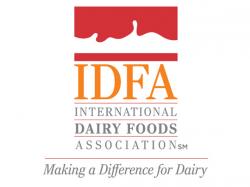IDFA Commends FDA For Responding To Issues With New Nutrition Facts Panel
May 23, 2016 | 3 min to read

Washington D.C. – The International Dairy Foods Association today acknowledged the U.S. Food and Drug Administration’s update of the Nutrition Facts panel, welcoming the agency’s willingness to make some reasonable revisions to the Nutrition Facts panel prior to issuing its final rules, while continuing to express concern regarding the declaration of added sugars now required on the label.
“The Nutrition Facts panel is an important part of nearly every food package sold in the United States and serves as an integral component of nutrition education and information for consumers,” said Cary Frye, IDFA vice president for regulatory and scientific affairs. “As such, it is important that the Nutrition Facts panel reflect the very best nutritional science available.”
The new label features a reformatted design with more prominence on calories, updates some of the Daily Values intended to indicate to consumers whether a product is high or low in particular nutrients and updates serving sizes and labeling requirements for certain package sizes. It also adds vitamin D and potassium as nutrients that must be declared, joining calcium and iron on the label. During the comment period on the proposed new rule, IDFA outlined concerns regarding changes to serving size of ice cream.
IDFA asked that the proposed Reference Amount Customarily Consumed (RACC), a measure of the amount of food that is usually eaten in one sitting, for ice cream be reexamined. The current RACC for bulk ice cream, which refers to multi-serve containers such as pints and half gallons, is a one-half cup. In the proposed rule, FDA recommended that this be doubled to one cup, which would have required significant reformulation for ice creams labeled as "low fat" since this claim is based on the grams of fat per RACC. Under the final rule, the RACC for larger containers of ice cream and also novelties, such as individual cups and ice cream bars, is a two-thirds cup. The RACC for yogurt, including drinkable yogurts, will change from eight ounces to six ounces, which was requested by the yogurt industry to align with the most popular serving size in the marketplace.
“We truly appreciate that FDA listened to our concerns about revaluating the serving size for ice cream and frozen dessert products” said Frye.
The biggest change to the proposed Nutrition Facts panel is a new requirement to declare “added sugars” in both gram amount as well as a percent Daily Value on a new line following the existing declaration of total sugar in a serving of a product. IDFA opposed this revision in comments filed with FDA.
Another specific issue raised by IDFA was that dried and concentrated dairy ingredients, such as whey, nonfat dry milk, or milk protein concentrates, and lactose, which is naturally occurring sugar in milk, should not be included in the added sugars definition because they are not added for sweetening purposes. In the final rule, FDA updated the definition of added sugars so that dairy ingredients with lactose as the primary ingredient are excluded from the definition, however lactose, in its pure form, when used as an ingredient added to foods or dairy products will be counted as an added sugar.
The final rule will be effective July 26, 2018 for food and beverage manufacturers with sales greater than $10 million; companies with sales below $10 million will have until July 26, 2019, to comply with the new rules.
# # #
The International Dairy Foods Association (IDFA), Washington, D.C., represents the nation's dairy manufacturing and marketing industries and their suppliers, with a membership of 550 companies within a $125-billion a year industry. IDFA is composed of three constituent organizations: the Milk Industry Foundation (MIF), the National Cheese Institute (NCI) and the International Ice Cream Association (IICA). IDFA's nearly 200 dairy processing members run nearly 600 plant operations, and range from large multi-national organizations to single-plant companies. Together they represent more than 85 percent of the milk, cultured products, cheese, ice cream and frozen desserts produced and marketed in the United States. IDFA can be found online at www.idfa.org.
Source: The International Dairy Foods Association (IDFA)
